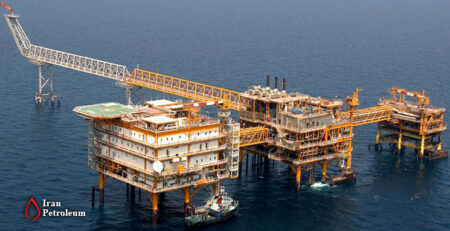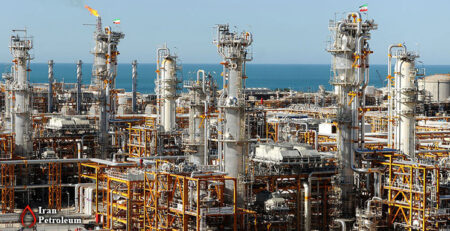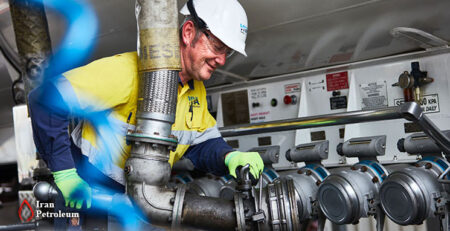Several Petroleum and Oilfield and Power Projects launched in Khuzestan
Several Petroleum and Oilfield and Power Projects in Khuzestan Province were inaugurated on the weekend in the presence of President Ebrahim Raisi.
A total of 15 oil and gas projects worth $3 billion were launched in the southwestern oil-rich province.
Among the major projects, the first phase of Persian Gulf Hoveyzeh Gas Refining Company was launched for collecting associated petroleum gases from several oil and gas fields, the Oil Ministry’s news service Shana reported.
Also known as NGL 3200, the refinery is located in Hoveyzeh County and seeks to protect the environment by collecting APG from Yadavaran, South and North Azadegan, South and North Yaran, Darkhoein, Sohrab, Jofeir, Susangerd and Band-e Karkheh fields.
The project comprises two phases, with each phase having a daily APG processing capacity of about 7 million cubic meters. The second phase of Hoveyzeh Refinery has so far registered over 80% progress and is expected to be completed within a year. The two phases of the refinery’s annual revenues will be around $500 million.
The plant will inject sweet gas into the national grid while heavy compounds and condensates, as feedstock, will be delivered to provincial petrochemical complexes in Mahshahr Petrochemical Special Economic Zone through a pipeline.
About 85% of the equipment used in the project have been manufactured domestically.
A total of $1.4 billion have been invested in the project and it has created employment for 5,000 people.
Natural gas liquids or NGLs are components of natural gas separated from gas in the form of liquids. Ethane, propane, butane, isobutane and pentane are all NGLs used for a variety of purposes like inputs for petrochemical plants, burned for space heating and cooking, and blended into vehicle fuel.
APG, or flare gas, is gas dissolved in oil. It is a mixture of hydrocarbons obtained from oil extraction and separation processes. The gas can be utilized in a number of ways after processing: as feedstock in the petrochemical industry and for gas distribution networks.
Its collection is an important safety measure at oil and gas production sites, as it prevents industrial plant equipment from over-pressuring and exploding.
Iran has made progress in using flare gas either for power generation or as feed for refineries and petrochemical plants. Reports say the government has invested $5 billion in related projects.
The Oil Ministry has implemented several measures to reduce gas flaring, such as collecting APG for injection into oil and gas wells, and for converting it into petroleum products like natural gas liquids and for power production.
Sohrab Oilfield
The executive operation to develop Sohrab Oilfield near the Iran-Iraq border also started on Friday.
Iran shares the Sohrab Oilfield with Iraq. The field is estimated to hold 2 billion barrels of oil in place, 160 million barrels of which are recoverable.
The National Iranian Oil Company concluded an agreement with the Tehran-based Dana Energy Company last year to develop the field.
The $850 million contract is aimed at extracting 160 million barrels of crude from the field over the next 20 years and its daily output is expected to reach 30,000 barrels by 2025.
The deal is in line with government plans to boost oil output from joint hydrocarbon deposits. Iran owns 145 oil and gas fields, of which 26 are shared with neighbors, including Kuwait, Iraq, Qatar, Bahrain, the UAE, Saudi Arabia and Turkmenistan.
The project includes drilling 20 wells, installing 14 electrical submersible pumps on production wells, constructing and upgrading ground facilities, implementing enhanced oil recovery methods and laying oil and gas pipelines.
It also entails the construction of a central treatment and export plant, a firefighting facility, a permanent camp and warehouses.
The oilfield was supposed to be developed by Wintershall, Germany’s largest oil and gas producer in 2018, but it terminated the contract after the US administration imposed sanctions on Iran in the same year.
The previous US administration unilaterally withdrew from the 2015 nuclear deal signed between Iran and six world powers in 2018. It reimposed sanctions on Iran, targeting its key economic sectors, namely oil, banking and shipping industries.
Sohrab Oilfield is located 115 kilometers northwest of the city of Ahvaz in Hoor al-Azim Wetland.
Dana Energy is a private oil and gas company active in exploration and production, upstream services and energy trading. It was among the first group of domestic companies certified in 2017 for cooperation in oil and gas projects alongside foreign contractors.
Dokouheh Power Plant
The gas unit of Dokouheh Combined-Cycle Power Plant near Andimeshk City came on stream on Thursday.
Benefiting from an F-class turbine, the gas unit will help provide reliable and stable electricity in the southwestern province, especially in the hot season.
The advanced F-class turbine used in the plant is the third of its kind in the country. With a capacity of 307 MW, it has been manufactured at the Turbine Engineering and Manufacturing Company (TUGA), a subsidiary of MAPNA Group.
It consumes less gas and is more eco-friendly. This type of turbine increases electricity generation in a simple- and combined-cycle power plant by 40% and 59% respectively.
Dokouheh Power Plant is built on 50 hectares. In addition to the gas unit, the plant will have a steam unit with a capacity of 144 MW.
A combined-cycle power plant uses both gas and steam turbines to produce up to 50% more electricity from the same fuel than a traditional simple cycle plant. The waste heat from gas turbine is sent to a nearby steam turbine, which also generates electricity.
MAPNA Group, a conglomerate of Iranian companies, is involved in the development and execution of thermal and renewable power, and plays a key role in upgrading the key power industry.
German engineering giant Siemens, one of the world’s biggest turbine manufacturers, signed an agreement with MAPNA in 2017 to help modernize Iran’s energy infrastructure.
As part of the agreement, MAPNA acquired the know-how to manufacture Siemens F-class gas turbines in Iran. Now local engineers are capable of manufacturing this type of turbines.
Established in 1999, TUGA manufactures turbines and other equipment for the power industry.
In the past decade, TUGA has manufactured over 300 gas and steam turbines with a nominal capacity of 32,000 MW.
Published: Apr 28, 2023
If you want to order petroleum, petrochemical and chemical products from Iran, please do not hesitate to send Iran Petroleum an email.












Leave a Reply